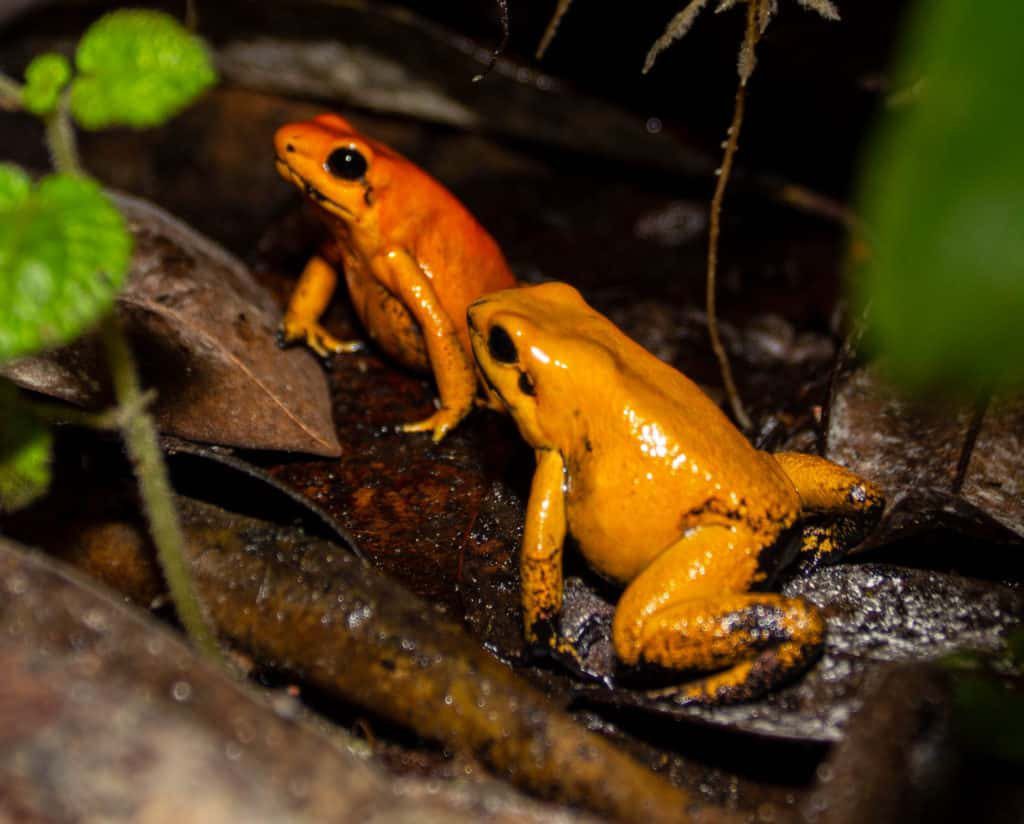Poison dart frogs, known for their vibrant colors and potent toxins, are a favorite among hobbyists. However, a recent study, Divergence, gene flow and the origin of leapfrog geographic distributions: The history of color pattern variation in Phyllobates poison-dart frogs, has revealed that there’s more to these fascinating creatures than meets the eye.
The research, conducted by a team of scientists, delved into the genetic and evolutionary processes that shape the diversity of these frogs. They found that the genetic structure of these species is complex, with evidence of high levels of gene flow between neighboring populations but not over long distances. This suggests that these species have not been completely isolated from each other, leading to a complex evolutionary history.
Interestingly, the study revealed the existence of several previously unrecognized lineages. For instance, the populations currently classified as P. bicolor were found to be two clearly separate and independent lineages. This points to a greater discordance between coloration phenotypes and genetic similarity than previously thought.
The researchers also found a strong relationship between color pattern and size, with solid-yellow lineages being significantly larger than striped ones. However, they found a much weaker relationship between coloration and toxicity. These results suggest that at least two co-evolving traits (solid yellow coloration and larger size), possibly related to predator avoidance, are distributed in a leapfrog fashion in Phyllobates.
The study also highlighted the importance of geographic and environmental factors in shaping the genetic structure of these species. For instance, fluctuations in sea level, temperature, and vegetation in the central Chocó region may have promoted periodic retractions of Phyllobates populations towards the San Juan, resulting in increased rates of gene flow among them.
So, why is this important for hobbyists and conservation efforts?
Understanding these complex genetic and evolutionary processes can help hobbyists make informed decisions about breeding and conservation efforts. For instance, recognizing the existence of separate lineages can guide breeding programs to maintain the genetic diversity of these species.
Moreover, the study underscores the importance of preserving specific locales. Changes in the environment can affect the genetic structure and diversity of these species. Therefore, preserving their natural habitats is crucial not only for their survival but also for maintaining their genetic diversity.
In conclusion, this research sheds light on the hidden diversity of poison dart frogs and emphasizes the importance of informed breeding and conservation efforts. It’s a reminder that preserving the beauty and complexity of these creatures goes beyond their vibrant colors—it’s also about preserving their hidden genetic diversity.
The research team used a variety of techniques, including transcriptome sequencing, enrichment probe design, DNA library preparation, target enrichment, and sequencing, to investigate the genetic structure and phylogenetic relationships of the Phyllobates species.
They found that the genetic structure of these species is complex, with evidence of high levels of gene flow between neighboring populations but not over long distances. This suggests that these species have not been completely isolated from each other, leading to a complex evolutionary history.
The researchers identified several distinct lineages within the Phyllobates genus. Specifically, they found that:
The populations currently classified as P. bicolor actually represent two separate and independent lineages. This suggests that there is a greater discordance between coloration phenotypes and genetic similarity than previously thought.
The populations currently grouped under P. aurotaenia represent multiple independently-evolving lineages. Some of these have probably been reproductively isolated for enough time to warrant recognition as separate species.
They revealed the existence of three independent solid-yellow lineages, instead of two as previously thought.
The researchers also found a strong relationship between color pattern and size, with solid-yellow lineages being significantly larger than striped ones. However, they found a much weaker relationship between coloration and toxicity. These results suggest that at least two co-evolving traits (solid yellow coloration and larger size), possibly related to predator avoidance, are distributed in a leapfrog fashion in Phyllobates.
The study also highlighted the importance of geographic and environmental factors in shaping the genetic structure of these species. For instance, fluctuations in sea level, temperature, and vegetation in the central Chocó region may have promoted periodic retractions of Phyllobates populations towards the San Juan, resulting in increased rates of gene flow among them.
These findings highlight the complexity and diversity of poison dart frogs, and underscore the importance of careful breeding and conservation efforts to maintain this diversity. They also emphasize the importance of preserving specific locales, as changes in the environment can affect the genetic structure and diversity of these species.

In this study, the researchers identified several distinct lineages within the Phyllobates genus. Specifically, they found that:
The populations currently classified as P. bicolor actually represent two separate and independent lineages. This suggests that there is a greater discordance between coloration phenotypes and genetic similarity than previously thought.
The populations currently grouped under P. aurotaenia represent multiple independently-evolving lineages. Some of these have probably been reproductively isolated for enough time to warrant recognition as separate species.
They revealed the existence of three independent solid-yellow lineages, instead of two as previously thought.
These findings highlight the complexity and diversity of poison dart frogs, and underscore the importance of careful breeding and conservation efforts to maintain this diversity. They also emphasize the importance of preserving specific locales, as changes in the environment can affect the genetic structure and diversity of these species.
Divergence, gene flow and the origin of leapfrog geographic distributions: The history of color pattern variation in Phyllobates poison-dart frogs by Roberto Márquez et al. (Published on 2020-02-25)
Amézquita, A., Marquez, R., Medina, I., Mejía-Vargas, D., Ospina, O., Palacios-Rodriguez, P., … & Santos, J. C. (2020). Leapfrogging and long-distance dispersal: the co-distribution of color phenotypes and genetic lineages in the poison frog Phyllobates. bioRxiv.
